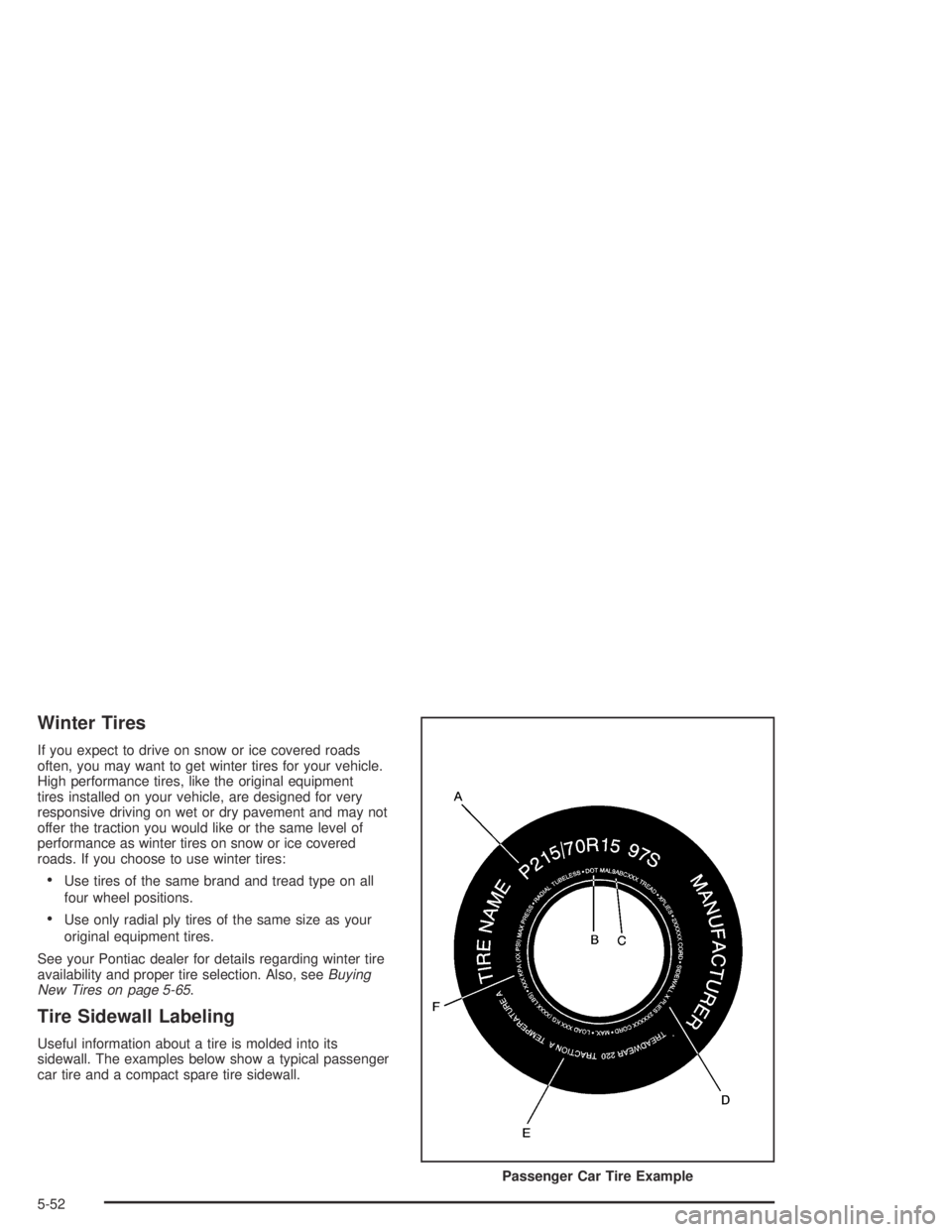wheel size PONTIAC GTO 2004 Owners Manual
[x] Cancel search | Manufacturer: PONTIAC, Model Year: 2004, Model line: GTO, Model: PONTIAC GTO 2004Pages: 326, PDF Size: 2.24 MB
Page 242 of 326

Winter Tires
If you expect to drive on snow or ice covered roads
often, you may want to get winter tires for your vehicle.
High performance tires, like the original equipment
tires installed on your vehicle, are designed for very
responsive driving on wet or dry pavement and may not
offer the traction you would like or the same level of
performance as winter tires on snow or ice covered
roads. If you choose to use winter tires:
•Use tires of the same brand and tread type on all
four wheel positions.
•Use only radial ply tires of the same size as your
original equipment tires.
See your Pontiac dealer for details regarding winter tire
availability and proper tire selection. Also, seeBuying
New Tires on page 5-65.
Tire Sidewall Labeling
Useful information about a tire is molded into its
sidewall. The examples below show a typical passenger
car tire and a compact spare tire sidewall.
Passenger Car Tire Example
5-52
Page 245 of 326

Tire Size
The following illustration shows an example of a typical
passenger car tire size.
(A) Passenger (P-Metric) Tire:The United States
metric tire sizing system uses the letter “P” to designate
a passenger vehicle tire. The European metric tire
sizing system does not use the letter “P” to designate a
passenger vehicle tire.(B) Tire Width:The three-digit number indicates the
tire section width in millimeters from sidewall to sidewall.
(C) Aspect Ratio:A two-digit number that indicates
the tire height-to-width measurements. For example, if
the tire size aspect ratio is “70,” as shown in item “C” of
the illustration, it would mean that the tire’s sidewall is
70% as high as it is wide.
(D) Construction Code:A letter code is used to
indicate the type of ply construction in the tire. The
letter “R” means radial ply construction; the letter “D”
means diagonal or bias ply construction; and the
letter “B” means belted-bias ply construction.
(E) Rim Diameter:Diameter of the wheel in inches.
(F) Service Description:These characters represent
the load range and the speed rating of a tire. The
load range represents the load carry capacity a tire is
certified to carry. The speed rating is the maximum
speed a tire is certified to carry a load. Speed ratings
range from “A” to “Z”.
5-55
Page 255 of 326

Buying New Tires
To find out what kind and size of tires you need, look at
the Tire and Loading Information label. For more
information about this label and where to find it, see
Loading Your Vehicle on page 4-30.
Make sure the replacements are the same size,
load capacity, speed rating and construction type
(bias, bias-belted or radial) as your original tires.
{CAUTION:
Mixing tires could cause you to lose control
while driving. If you mix tires of different sizes
or types (radial and bias-belted tires), the
vehicle may not handle properly, and you
could have a crash. Using tires of different
sizes may also cause damage to your vehicle.
Be sure to use the same size and type tires on
all wheels. It’s all right to drive with your
compact spare temporarily, it was developed
for use on your vehicle. See “Compact Spare
Tire” in the index.
{CAUTION:
If you use bias-ply tires on your vehicle, the
wheel rim �anges could develop cracks after
many miles of driving. A tire and/or wheel
could fail suddenly, causing a crash. Use only
radial-ply tires with the wheels on your vehicle.
5-65
Page 259 of 326

Used Replacement Wheels
{CAUTION:
Putting a used wheel on your vehicle is
dangerous. You can’t know how it’s been used
or how far it’s been driven. It could fail
suddenly and cause a crash. If you have to
replace a wheel, use a new GM original
equipment wheel.
Tire Chains
{CAUTION:
Don’t use tire chains. There’s not enough
clearance. Tire chains used on a vehicle
without the proper amount of clearance can
cause damage to the brakes, suspension or
other vehicle parts. The area damaged by the
tire chains could cause you to lose control of
your vehicle and you or others may be injured
in a crash. Use another type of traction device
only if its manufacturer recommends it for use
on your vehicle and tire size combination and
road conditions. Follow that manufacturer’s
instructions. To help avoid damage to your
vehicle, drive slowly, readjust or remove the
device if it’s contacting your vehicle, and don’t
spin your wheels. If you do �nd traction
devices that will �t, install them on the
rear tires.
5-69
Page 324 of 326

Some Other Rainy Weather Tips.......................4-18
Special Fabric Cleaning Problems.....................5-80
Specifications, Capacities.................................5-92
SPEED DEPENDENT VOLUME........................2-35
Speedometer..................................................3-25
Starting Your Engine.......................................2-17
Steering.......................................................... 4-9
Steering in Emergencies..................................4-10
Steering Tips................................................... 4-9
Steering Wheel Controls, Audio.........................3-53
Steering Wheel, Tilt Wheel................................. 3-5
STOP WATCH ................................................2-34
Stop Watch....................................................3-39
Storage Areas
Center Console Storage Area........................2-31
Cupholder(s)...............................................2-31
Front Storage Area......................................2-31
Glove Box..................................................2-30
Storing the Flat Tire and Tools..........................5-77
Storing the Spare Tire and Tools.......................5-77
Stuck in Sand, Mud, Ice or Snow......................4-28
Sun Visors.....................................................2-12
T
Tachometer....................................................3-25
Telescopic Steering Column............................... 3-5
Theft-Deterrent, Radio.....................................3-52
Theft-Deterrent System....................................2-12Theft-Deterrent Systems
Content Theft-Deterrent................................2-14
Immobilizer.................................................2-12
Immobilizer Operation...................................2-13
Tilt Wheel........................................................ 3-5
TIME TO ARRIVAL.........................................3-37
Tire Inflation Check.........................................6-10
Tire Sidewall Labeling......................................5-52
Tire Size.......................................................5-55
Tire Terminology and Definitions........................5-56
Tires.............................................................5-51
Buying New Tires........................................5-65
Chains.......................................................5-69
Changing a Flat Tire....................................5-71
Compact Spare Tire.....................................5-77
If a Tire Goes Flat.......................................5-70
Inflation - Tire Pressure................................5-58
Inspection and Rotation................................5-62
Uniform Tire Quality Grading.........................5-66
Wheel Alignment and Tire Balance.................5-67
Wheel Replacement.....................................5-68
When It Is Time for New Tires......................5-64
Top Strap......................................................1-36
Top Strap Anchor Location...............................1-37
Torque Lock...................................................2-25
Towing
Recreational Vehicle.....................................4-30
Towing a Trailer..........................................4-35
Your Vehicle...............................................4-29
12